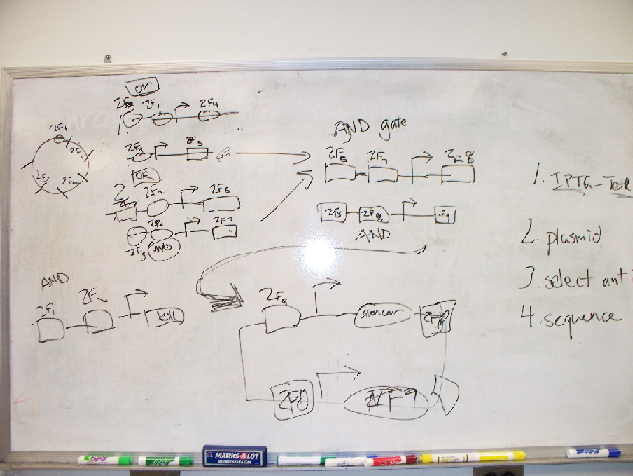Team:Duke/Project
From 2011.igem.org
(→Project Details) |
(→Network Design) |
||
| Line 28: | Line 28: | ||
=== Network Design === | === Network Design === | ||
| + | A variety of Network designs using zinc finger transcription factors were considered before we settled on the Genetic Toggle Switch. Some of the rejected designs included novel uses of AND/OR gates to create a "bacterial encryption security" system. Network design began with simple white board drawings before moving on to more sophisticated drawing and modeling software. | ||
| + | [[File:posdesign.JPG]] | ||
| + | In redesigning the genetic toggle switch we sought to retain the following important characteristics of the original toggle switch. | ||
| + | <html> | ||
| + | <body><p> | ||
| + | <br/> | ||
| + | -Bi-stability<br/> | ||
| + | -Low Basal Transcriptional Noise<br/> | ||
| + | -Toggling via Chemical Inducers<br/> | ||
| + | -Usage of Constitutive Repressible Promoters<br/> | ||
| + | -Usage of fluorescent proteins to indicate stable states<br/> | ||
| + | <br/> | ||
| + | </p></body> | ||
| + | </html> | ||
| + | In order to redesign the genetic toggle switch we used a variety of programs including ApE (A plasmid Editor) to string together the sequences for our plasmids and TinkerCell to create a diagram of our network as well as to model the network dynamics using stochastic differential equations. | ||
=== Bacterial 2-Hybrid Assay === | === Bacterial 2-Hybrid Assay === | ||
== Results == | == Results == | ||
Revision as of 03:35, 29 September 2011
| Home | Team | Official Team Profile | Project | Parts Submitted to the Registry | Modeling | Notebook | Safety | Attributions |
|---|
Contents |
Overall project
Additions to the synthetic biologists' toolkit are expected to be interoperable and modular in order to facilitate standardization of these tools. The Genetic Toggle Switch originally presented by Gardner et al (2000) was a major breakthrough in synthetic biology and utilized constitutive promoters. Here, we use Zinc Fingers as transcriptional repressors in a newly designed interfacing network, the controller, for a modified version of the original toggle switch. The controller interface is made with emphasis on interoperability and applications in mind. Specifically, we use zinc finger repressors and degradation tags to reduce cross-talk and make the network more robust. Nine ZF transcription factors are computationally characterized and submitted to the registry. The interfacing controller and toggle switch are stochastically modeled to predict gene expression levels and are subjected to experimental testing.
Project Details
Network Design
A variety of Network designs using zinc finger transcription factors were considered before we settled on the Genetic Toggle Switch. Some of the rejected designs included novel uses of AND/OR gates to create a "bacterial encryption security" system. Network design began with simple white board drawings before moving on to more sophisticated drawing and modeling software.
In redesigning the genetic toggle switch we sought to retain the following important characteristics of the original toggle switch.
-Bi-stability
-Low Basal Transcriptional Noise
-Toggling via Chemical Inducers
-Usage of Constitutive Repressible Promoters
-Usage of fluorescent proteins to indicate stable states
In order to redesign the genetic toggle switch we used a variety of programs including ApE (A plasmid Editor) to string together the sequences for our plasmids and TinkerCell to create a diagram of our network as well as to model the network dynamics using stochastic differential equations.
 "
"

